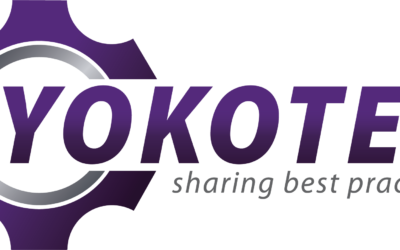One goal for 2018…
… and 10 key practices for the top management!
In Toyota I was thaught that ‘building something’ is nothing more than ‘buiding’ people’s motivation. I suggest that in 2018, the top management in each company should set themselves one goal, one KPI. Yes, one goal, One KPI, which will affect performance, commitment, quality, safety at work, availability, delivery time, lead time or profitability at the first contribution level (m1).
The objectives for 2018. It is important that every employee, and in particular those who ‘touch’ the processes we invoice every day, know that we appreciate their ideas and suggestions. We want them to tell us what they would need to do to improve their processes in their daily work. The concept is straight-forward – we want their work to be easier, safer and in this way, having this approach, we reduce unnecessary behaviors, processes, procedures, meetings to ‘make their lives easier’.
My experience has taught me that most managers are struggling with what and how to do to get employees to share their Ideas, Breakdowns and Problems easily and honestly, which I call ‘the most valuable PAPs’.
Of course, I suggest a complex introduction of the Continuous Improvement Programme – PCD, whose extremely important element is to focus on the employee who is engaged in reducing costs, improving quality and safety. The PCD program is also a whole set of solutions that allow not only to transform processes and methods of operation, but also to transform the company into a learning and self-improvement organization, thanks to which it becomes more and more competitive in its sector. For now, however, I will focus on just a few of the practices I learned at Toyota.
- Each employee must have their own Individual Development Programme – IPR. Not only we develop our employees, but each of them knows what we expect from them. We spend a significant amount of time with our employees, we do not send them to our training room, but we develop them in the workplace. In Toyota we call it on-the job-development – OJD. Each employee gets his/her sensei (teacher), who teaches him/her such things as: standardization of his/her process, visualization of his/her work results, how to solve problems, describing his or her PAPs, rules (we have six of them in PCD) that are important for him/her,etc. The IPR is an operational tool in the implementation of Hoshin Kanri’s strategy.
- Involve your employees so they understand that we constantly expect them to improve. We need to show our employees a proactive attitude towards continuously improving what was already recognized as a good standard yesterday. The first question from a Shift Leader or a Shift Manager should be, “Hi, how’s your process going? If an employee has a PAP, his/her supervisor should take care of him/her as soon as possible. We don’t need any boxes of ideas or committees for that.
- Empower employees to make changes. If an employee or his/her team can make changes (describe and standardise them) so the company should introduce a management approach that makes it possible.
Let’s specify that all PAP’s are implemented either by the employee, his/her team or other people within 30 days of creating the idea. It is essential for company to show in a pragmatic way that all PAP’s from employees are significant. If we can’t make a change within 30 days, we have to give feedback to the employee about the reason for taking longer to introduce PAP or for not implementing it at all. Employees can’t lose hope and trust in PCD management system. - Consistently implement the Continuous Improvement Programme (PCD). I guess most of us don’t even know, but at Toyota we manage the company on a daily basis through standing meetings by the boards. The greatest secret is that Toyota does not disclose outside what the purpose of these meetings or the tasks themselves is. Quality assurance (ZJ) meetings are organized (where there is a line production – daily, in unit production – two/three times a week) in a standing position, by boards, we write down manually, without nice coloured charts. These meetings last up to 20 minutes and discuss quality issues. In addition, your company’s Quality Department should be proactive, not reactive. If this department is called “Quality Control Department”, please change its name to “Quality Assurance Department” from January 1, 2018. We do not control quality in the plant, but provide it. The difference is huge because all employees are involved in quality assurance and must understand how they can contribute to it.
There is only one small but fundamental problem here. All companies, even those in the automotive sector, meet at the whiteboards and are so focused on the tasks which are discussed during the meetings that almost all of them forget about the purpose of the meetings. However, this is not the case for now.
Within the PCD we manually enter our results on the board, KPI (next to other important items). The employee has contact with the goals and results because he has to enter the result of his work manually and with a marker, using the correct color. I believe when an employee (line leader, shift leader/foreman) introduces the result of his work, not through the computer and “Enter” ( and the thing is done), but on the board, during a meeting, he will identify himself more with his work. This method leads to self-responsibility and thinking about what I could do to improve this result. - Visualize – results, processes, stops, failures, ideas, health and safety, etc. so employees are informed about what is happening. I often hear: “But, Mr. Mark, we have everything on our computer and why do we need these white boards for? That is the problem. I know perfectly well that “everything” is on the computer. So what! I don’t need more than 5 minutes to prove that what’s on the computer doesn’t help us much. The subject of “plant management through visualization” is a big and wide area, and I don’t mean graphs. An example of such visualization is the presentation of working clothes, e.g.: an employee who has completed additional training and is somehow ‘entitled’ to save life is wearing clothing (an element) that identifies him/her.
- Work and accumulate knowledge in your own observations and through direct experience – genchi genbutsu as a standard for your working day. Go to the ‘crime scene’. On many occasions I emphasize in companies that there are operators and line leaders working in the plant and thanks to their hard work, the company invoices the finished product delivered to the customer. Primary value streams in your company are line employees. Everything and everyone else is there to support them. We go to the production for various reasons. The main ones are to practice mendomi with employees, support them and learn to observe. At least according to the PCD rules.
- Visit and listen to your clients. When was the last time the so-called ‘leaner’ from you visited a client, e.g. in the logistics department, in the accountant’s office, did he talk to a user of your product? It is easy to say that ‘the customer comes first’ and in practice it is not visible. The fact that a salesman knows the client’s expectations and that you trust the sales department is not the answer. In Toyota, the most accurate kaizen are the ones coming from the client.
- 2018 is the year of Kaizen beyond production. I propose to collect ideas (no box, no awards) in all other departments within the company, starting with those departments that are usually not very effective, in other words: the quality department, the health and safety department and the sales department. The next step is planning, controlling, accounting, purchasing, administration, construction, etc… I propose to set a goal that each employee should prepare no less than six ideas for improvement per year and implement them.
- Practice the principles and values of the Continuous Improvement Programme (PCD) daily throughout the day. A true lean leader is a accelerator of continuous improvement for other employees. Well, what would it look like on a daily basis? Here are a few examples. Is there an employee in your company who knows his or her job and is loyal but it is hard to work with him or her? Arrange a meeting with him/her. List three positive aspects and transform his negative attributes into positive or strong work/character assets. You practice the PCD principles in this way. Is there any towel paper on the bathroom floor? Clean it up and tell others at the next meeting that we don’t respect our workplace and that you cleaned the bathroom floor recently. You practice PCD in this way. Watch and listen to yourself carefully at the next meeting and promise yourself that you will treat all employees more politely. You practice PCD in this way.
- Celebrate much often in 2018 comparing to the previous year. Sorry to say, but I often see in companies that employees at various levels know how to party, but they are not able to celebrate in the company – they are masters in pointing out the guilty and punishing. I will give you some examples. Hold out your hand and say thank you – for many a difficult task to do. Say something positive and appreciate the fact that someone is doing his best at work, or has his own idea. Buy a bottle of cola or pizza, small snacks, or chocolate for employees at the end of the month or when they manage to do something well, finish or invent. Join this with a short conversation. Small gestures, positive words, a bit of culture will help to build a better place to stay for eight hours at work.
Building something is nothing more than buiding people’s motivation.
Kind regards,
Mark Forkun



